What do you want to know about Invora<sup>®</sup> herbicide?
There’s a lot of information about Invora® herbicide that could be useful to you. For example, it has the highest rating in the ERM-1466 Chemical Weed and Brush Control Reference Guide for Rangeland, and it reduces canopy cover better than any other herbicide to restore rangeland like nothing else.

